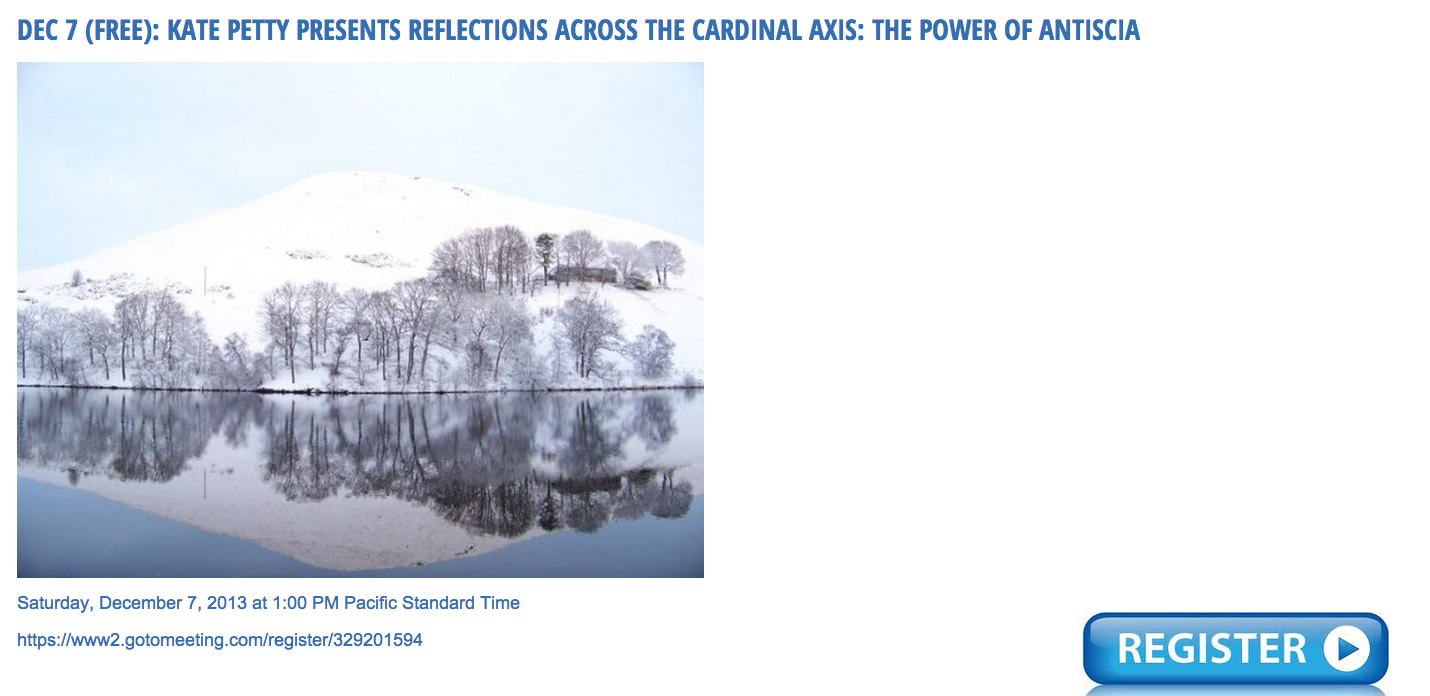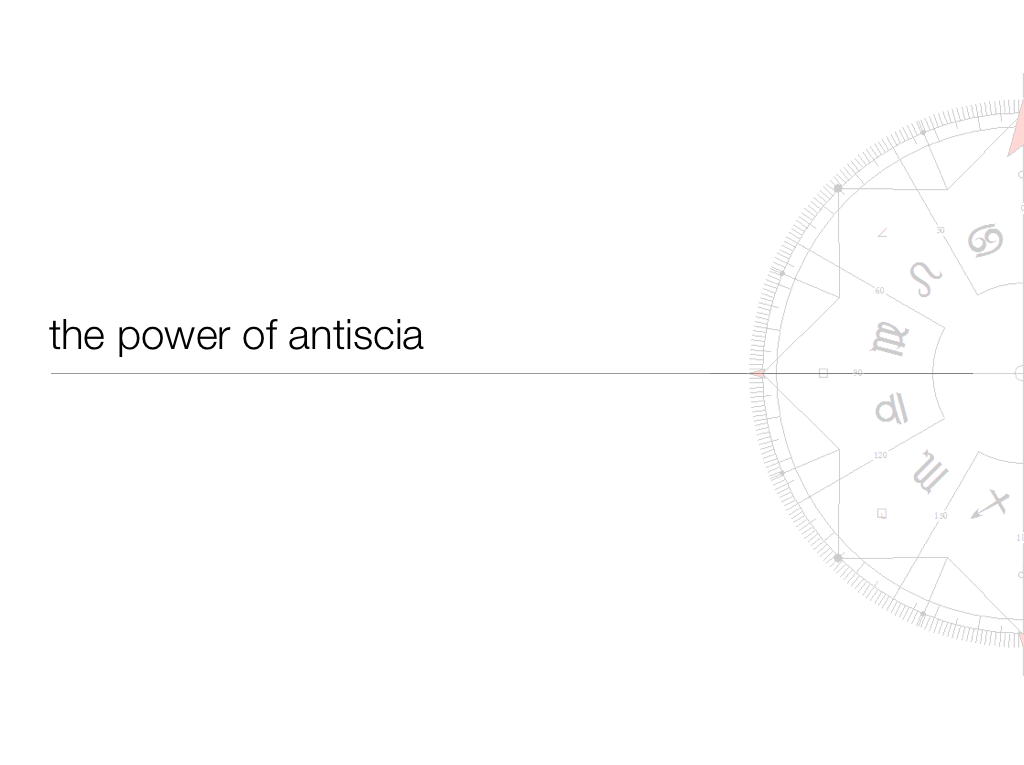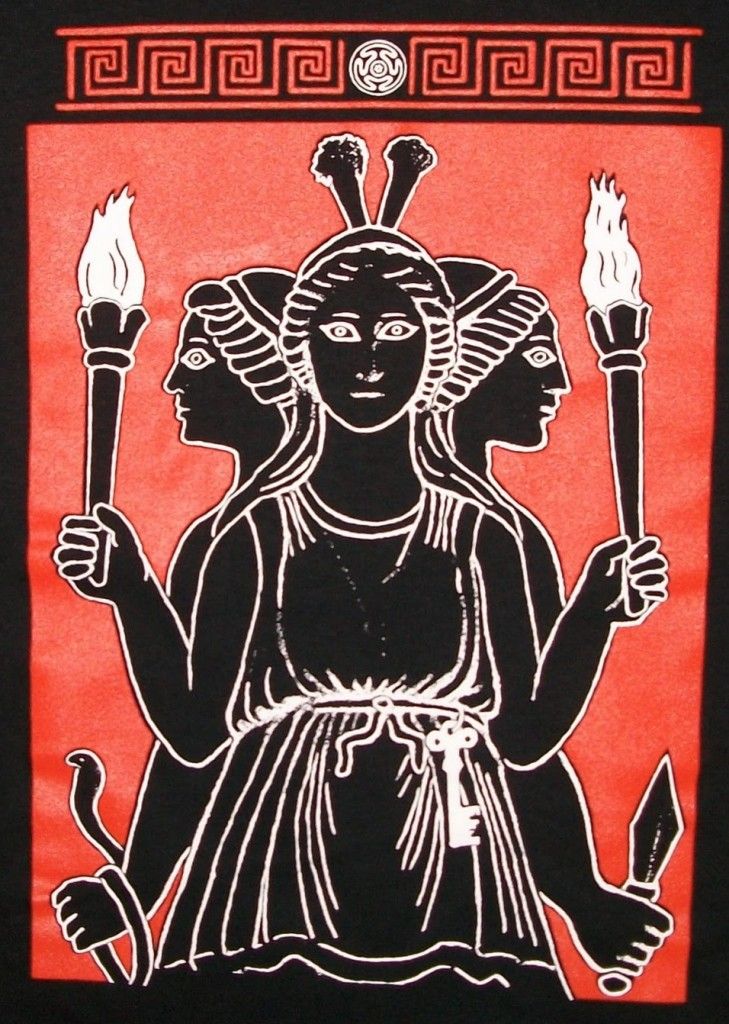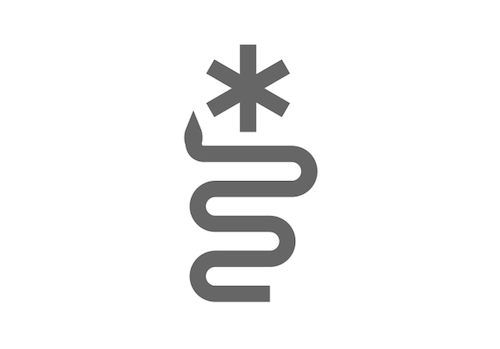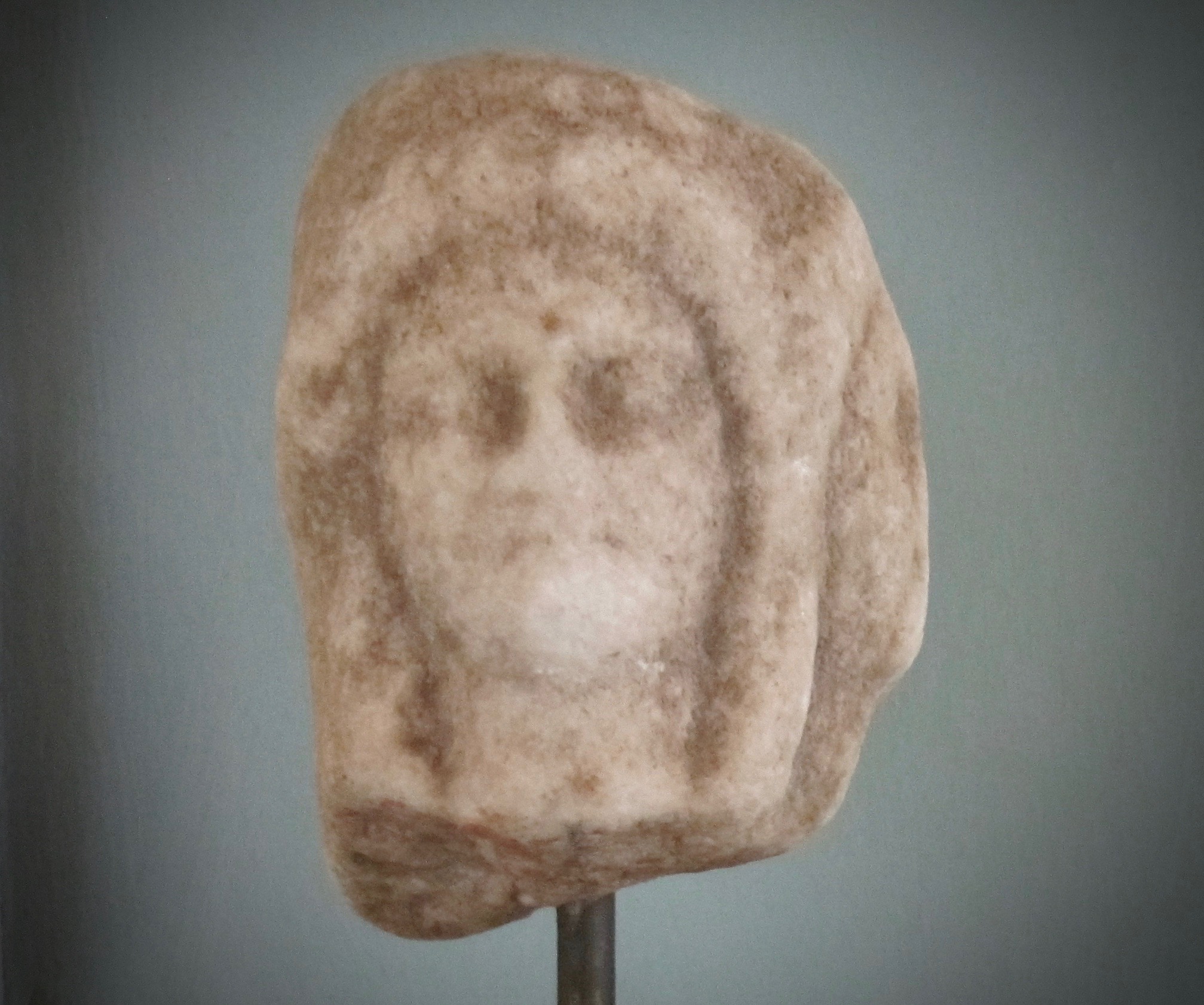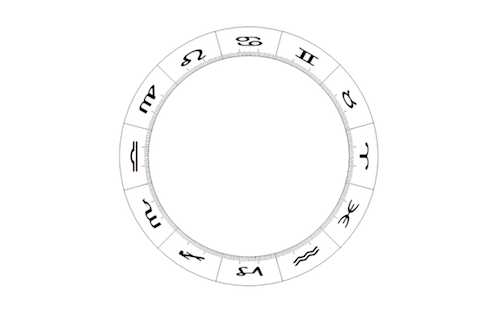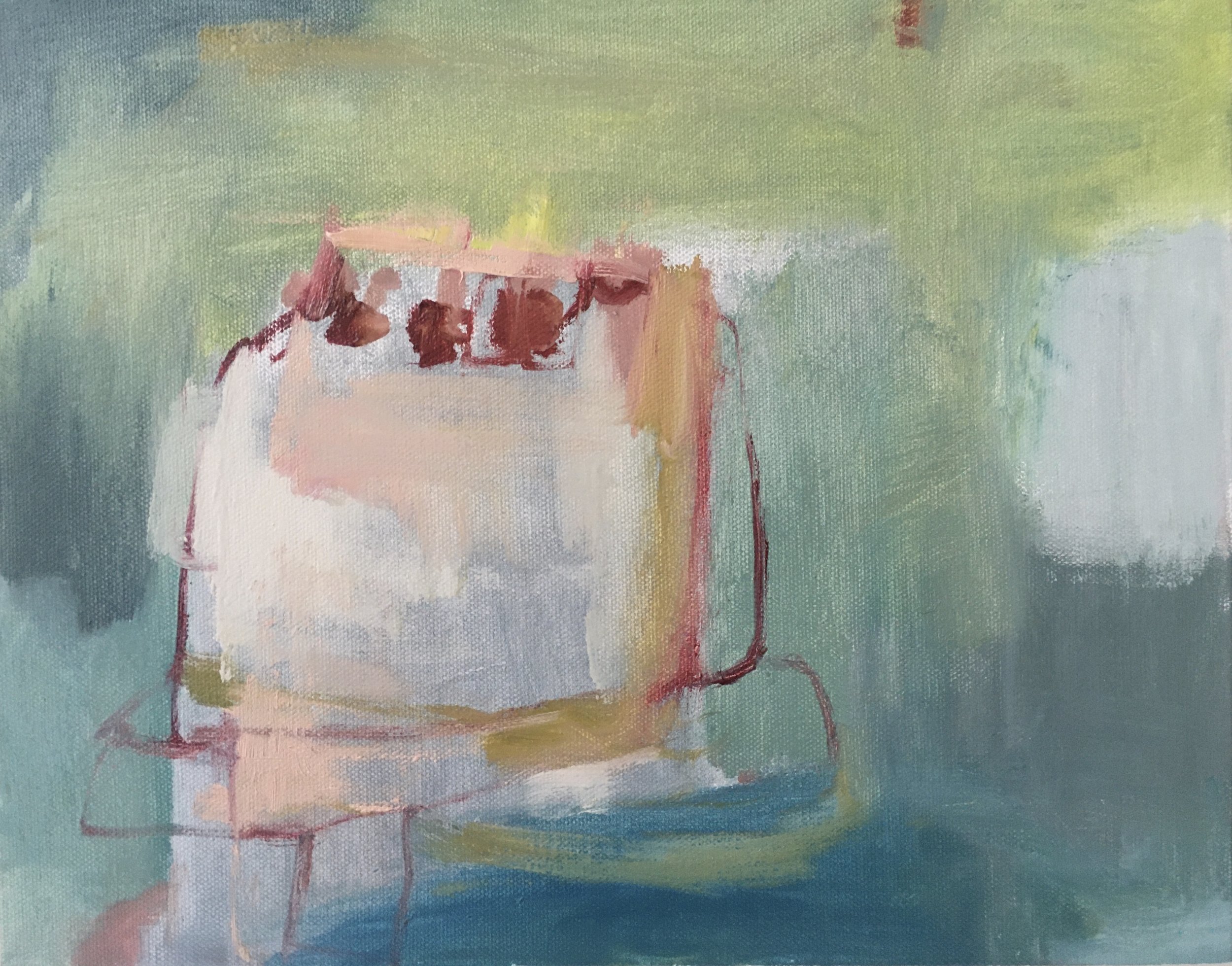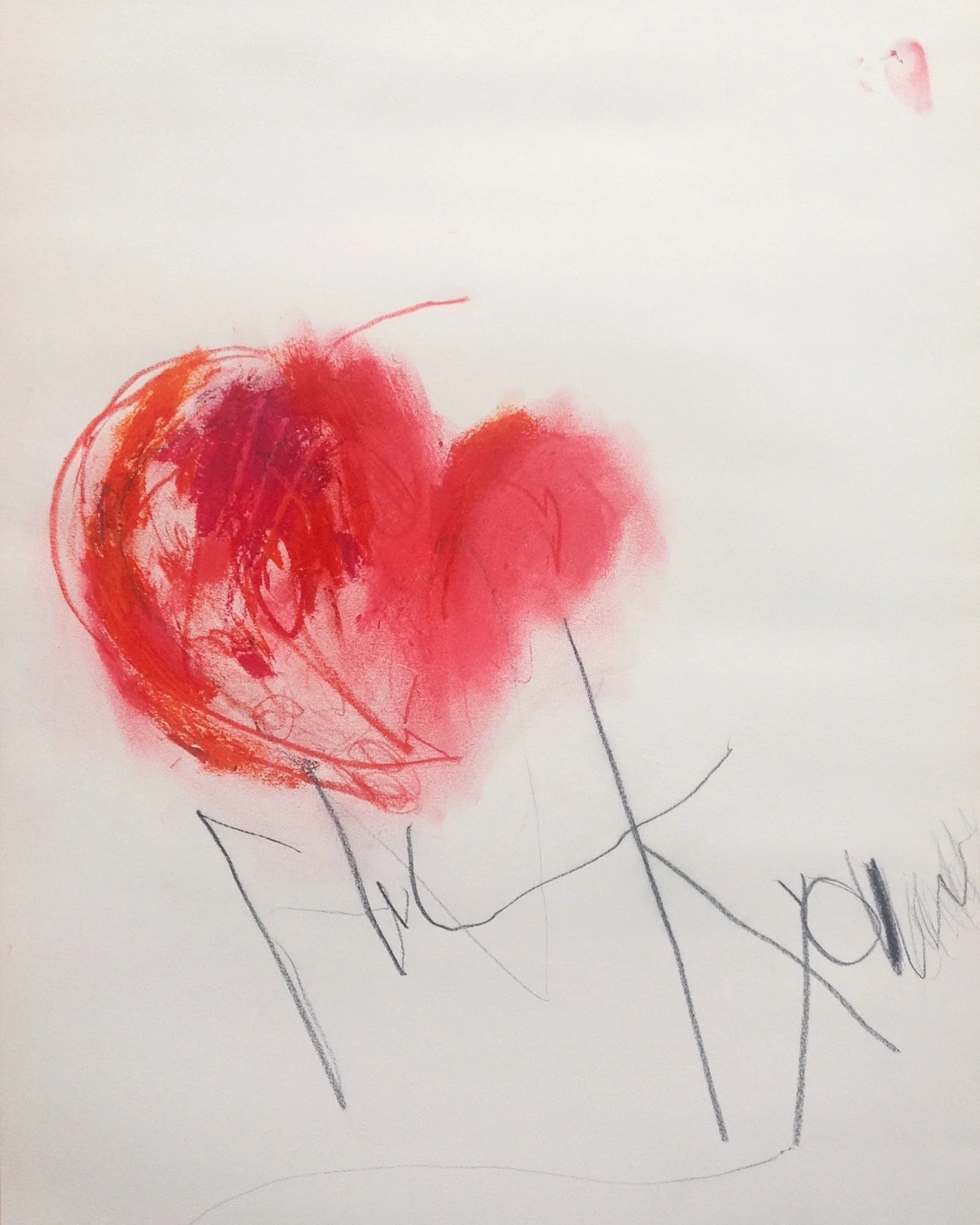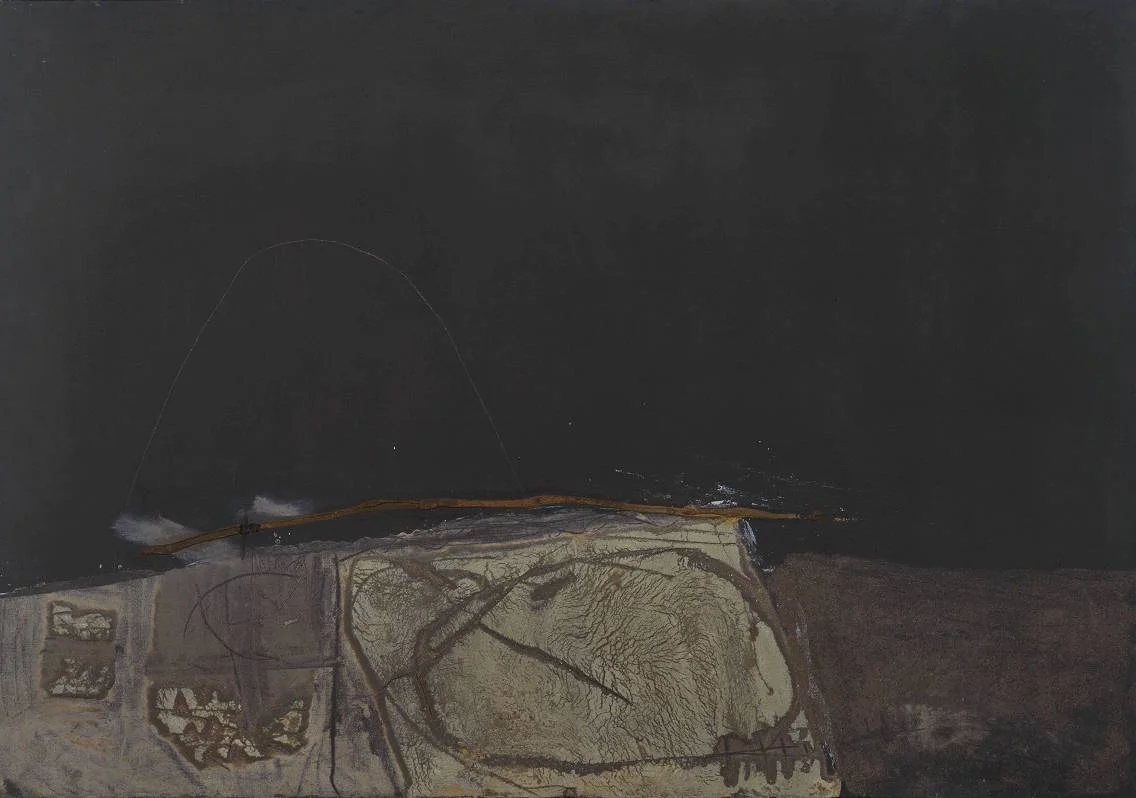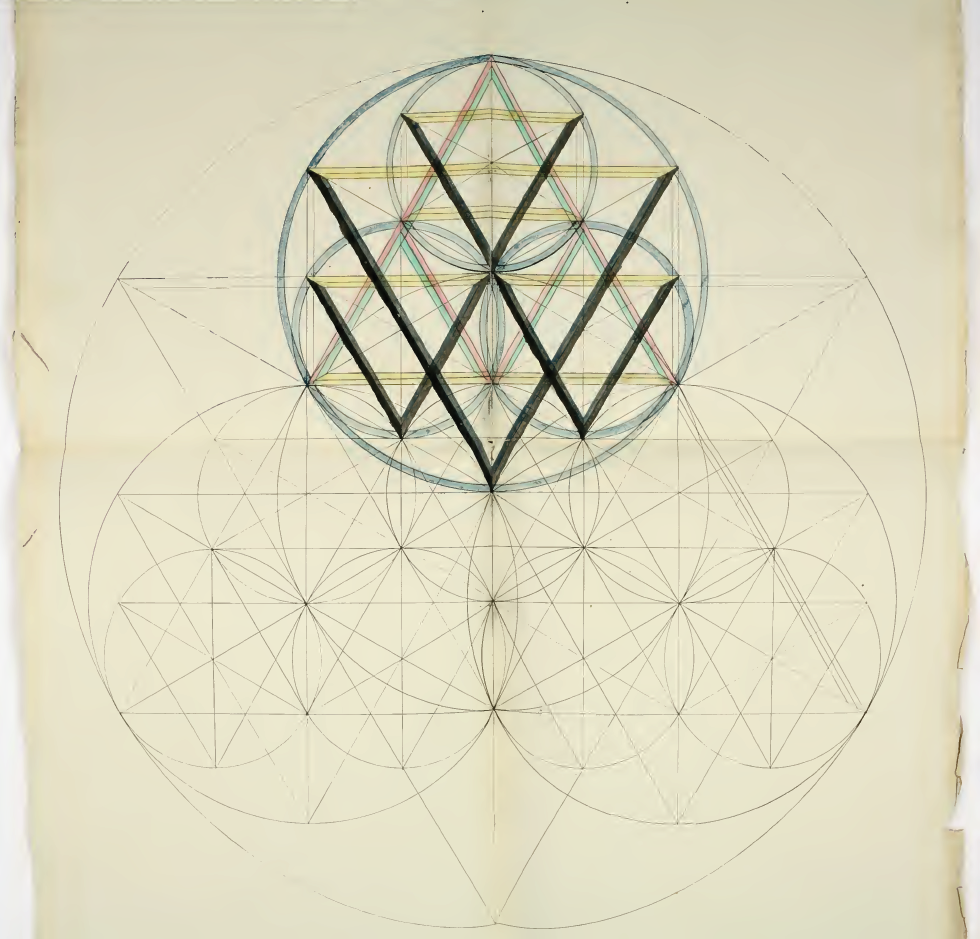Antiscia and the Thema Mundi
/An earlier version was published in December 2014.
“an energetic alliance that can be easily observed and/or experienced”
Why are connections by antiscia so obscure in astrology? — and why do most astrologers still consider these contacts second-rate aspects at best? … having some merit, but certainly not as meaningful as the Ptolemaic aspects: sextile, square, trine, and opposition.
Antiscia are reflections around the solstice and equinox points. They are symmetries based on the sharing of time and light. They are natural and simple. And they are anchored to the undeniably potent reset moment that is the Cardinal Axis. I think excluding them from having conjunction/aspect status is in error.
Antiscia in the Thema Mundi
I made a discovery many years ago while working with antiscia, and simultaneously studying Hellenistic and Persian astrology. I found antiscia shows up in the all-important Thema Mundi, a hypothetical chart of the world and teaching tool. This was something I’d never heard anyone mention before. Nor had I encountered it in the ancient texts that reference antiscia. I was astonished, and pleased to see the very obvious statement it makes.
You will see in the diagram below I’ve arranged the planets in their places of exaltation. I have noted the aspects that connect each planet back to their respective domiciles (signs). You can see both the nocturnal planets, Venus and Mars, connect to one of their domiciles by sextile. And the the diurnal planets, Jupiter and Saturn, connect to one theirs by trine. If you look to the lights, Sun and Moon, you’ll note they each connect by trine and sextile back to their respective domiciles. Which sets up a schema:
diurnal = trine | nocturnal = sextile
Then you’ll see how the malefics (and Mercury) connect to the other of its domiciles by square — and that each benefic, Venus and Jupiter, connects to the other of their respective signs by antiscia or contra-antiscia (known as the seeing and hearing signs to the ancients).
malefic = square | benefic = antiscia
All planets connect in two ways through two aspects.
Because malefics connect through a square aspect, and benefics through antiscia, I believe it is solid evidence for antiscia as a legitimate aspect, as well as describing the quality of the connection. And I find its presence in the Thema Mundi both profound and beautiful.
I believe aspects by antiscia are just as powerful as other aspects. Especially those in a close degree-based connection. (I suggest using a 4 degree orb—2 degrees on either side: applying and separating.)
As it is with the square, connections by antiscia and contra-antiscia cross boundaries and combine polarity—hot|cold, dry|moist, active|passive, day|night, male|female. This makes the pairs dynamic and alive in the world, much like we see with a square. They are active. They are combinations that demand our attention: we must do something with them.
This co-mingling of sect or gender, and temperament, along with the symmetry around the four seasonal turning points, a.k.a. Cardinal Axis (see other articles), is indicative of a very potent pairing: an energetic alliance that can be easily observed and/or experienced.
"the cardinal points relate people to the world at large"
-Charles Jayne, crediting Alfred Witte
The particular antiscia and contra-antiscia connections shown above could also be viewed as an averse pairing. However, it is undoubtedly relevant that the associations shown in the scheme are indeed antiscia (seeing) and contra-antiscia (hearing) links. The ancients regarded them as relaying sympathy and reception. And they are after all conveyed through the two creative convivial planets, moist, fertile, connective, Venus and Jupiter.
These are also signs of sharing. Signs which share power (equal amount of light = antiscia), and ascensional or rising time (contra-antiscia).
Seeing + Hearing
Signs that share light or “power” = antiscia
They fall equidistant around the Solstice points
Signs rising at the same speed = contra-antiscia
They are equidistant from the Equinox points
Example: for Hendrix the Moon in Cancer ‘sees’ Uranus in Gemini, they share power and light. The Sun in Sagittarius rises at the same speed as Jupiter in Cancer, they are said to ‘hear’ one another, and so there is sympathy and friendship.
“And so, if any stars do not aspect each other in the orderly arrangement of the nativity, it must be inquired whether they are connected to each other by the associated aspect of antiscions. For when they have sent their antiscions thus, they are connected with each other through their antiscions just as [much as] by a trine or square or opposition or sextile aspect...”
-Julius Firmicus Maternus, 4th century astrologer
in Book 2 Chapter 30 of the Mathesis (Holden translation, 2011)
“Signs that are disjunct but having sympathy for each other are all the equal-rising signs, and those having equal power, and those of like zone. For example, equal-rising are Aries and Pisces, Gemini and Capricorn, Cancer and Sagittarius, Virgo and Libra; of equal power are Gemini and Cancer, Virgo and Aries, Libra and Pisces, Sagittarius and Capricorn; of like zone are Taurus with Libra, Aries with Scorpio.
...with the joint risings of the signs and the joint ascensions of the stars...
friendships and sympathies of men and women, and parents and brothers, and friends and slaves.”
-Rhetorius of Egypt, 6th or 7th century, Ch.16 (Holden translation, 2009)
“[disjunct signs] ... are the ones which belong neither to the class of commanding or obeying, beholding or of equal power... ”
The presence of these aspects in the vitally important rulership and dignity schema, Thema Mundi, is a reality which should no longer be denied or dismissed. These points of connection have been overlooked for too long. It is time to fully embrace them and practice utilizing them in all forms of astrology!
There is much to uncover with antiscia! —See for yourself. ;-D
-
If you want to immerse yourself in this more, contact me for a mentoring session.
Or tune in to my recent talk for Kepler College (find the recording here).
A multimedia presentation available (approx. three hours in length):
“. . .undeniably potent reset moment”
URANIAN readings + PSYCHOLOGICAL insight
/Midpoints are an incredible tool for self-discovery and insight.
+ I now offer: Uranian/Symmetrical/Hamburg School/Cosmobiological readings.
Our astrology chart reflects our experience. Midpoints provide an even more detailed, nuanced view of our experiences. There are themes and patterns within each of us that are present throughout our entire lifetime. And at other times a distinct story or theme emerges as an event (outer experience) or an inner experience. At all times there are several themes, motifs, and processes unfolding simultaneously.
Some topics and patterns overlap and combine (a shared midpoint structure) which creates a wildly potent, very personalized motif. Sometimes a theme or event acts as a trigger for the literal or symbolic (exterior or interior) manifestation of an important matter, feeling, process, or time in your life. Through examining midpoints, planetary pictures, antiscia—and the myriad of timing techniques which accompany these methods—we can get a good sense of what is currently up for you, and how to work with it.
Midpoints conduct and guide energy. Like the apex of a T-square, they are focal or funnel points for planetary significations.
As symmetrical astrologers we work with direct and indirect midpoints, the latter some claim to be slightly less intense (I do not find this to be true when exact). Antiscia fall under this domain as they are simply midpoints around the four cardinal turning points (the equinoctial and solstitial axes). The cardinal points are sometimes just called the Aries Point—and are literally the sun's nodes. Actually, to be more precise, zero Aries is the ascending node of the sun while zero Libra marks the descending node, which puts the solstice points at 'the bendings' (or square) to the sun's nodes. [A topic that deserves deeper examination at another time.] The sun and its nodes are important because they are two of the six personal points we as Uranian astrologers are most concerned with. The moon and its nodes, the Ascendant, and the Midheaven are the other four. These are always thoughtfully examined in a reading.
There are also planetary pictures to analyze. (Midpoints are pictures as well.) A completed planetary picture is like a closed circuit statement, it speaks to major themes in a person's life. Planetary pictures are periodically triggered by transits or other timing methods, or across charts in synastry, and when this occurs it is often significant. There are also incomplete pictures (a.k.a. Parts or Lots) which seek a transit or other direction (or another person, i.e., synastry) to set off their significations. While transits and directions are fated (timing is predetermined), how we react, and with whom we relate, is within our control.
In the Uranian system we also sometimes employ the TNPs (TransNeptunian Planets) for nuanced delineation.
Read how Alfred Witte, the creator of the system, discovered them in this article.
Planetary Pictures or 'Lots' always create an isosceles trapezoid shape in the chart
the center of these midpoints is a significant axis
signs that reflect one other across the Solstice (Antiscia) and equinox (Contra-antiscia)
to Create midpoints focused on the cardinal axis or “Aries POint”
( = World stage) expression in the world
I now offer symmetrical/midpoint readings as a focus for chart work (75-minute consultation available for $150). The aim for this consultation is to discern a number of primary themes in your life, and determine which factors and motifs are emerging now through midpoints, planetary pictures, antiscia, and several key timing techniques.
I look forward to working with you!
10 Astrology Habits to Break
/1. Using the Astrological Alphabet
Whether you learned this from a teacher or read it in a book, please stop limiting yourself with the application of sign = planet = house style rulership. Indeed, Aries is the domain of Mars, and Taurus the domain of Venus (and on it goes). BUT this does not mean Aries/Mars is the same thing as the first house. It's simply not. A planet associated with war and separation does not equate to the house of Life, Body, Spirit. And Taurus/Venus does not equal the second house of your income (Jupiter is actually the planet pertaining to wealth). Scorpio is not equivalent to the eighth, Aquarius is not a stand in for the eleventh, Pisces is not interchangeable with the twelfth.
Aries may be the first sign of the zodiac, if you work that way. But there are other ways to work, and other perspectives to take. For instance, Capricorn could be the first sign of the zodiac: when it is darkest in the northern hemisphere, think of a gestating seed; or if that feels limited, when the sun has bottomed out and begins its travel upwards (from our perspective on earth) from its most southerly declination at the Tropic of Capricorn. Which is also close to the rotational center of the Milky Way—the Galactic Center.
Or you might want to think of the sign Cancer as the first position. As it is the first house in the all-important Thema Mundi (see the diagram below). Vettius Valens, in his Anthology from the second century, writes: it is the house of the moon, feminine, solstitial, the Ascendant to the universe…
With the Thema Mundi in mind, consider Jupiter's exaltation in Cancer (life giving and life promoting) versus Mars' exaltation in Capricorn (the seventh sign, and traditional house of death: the place of the setting sun). And Libra on the fourth, Saturn's place of exaltation: under ground, under earth, the crypt — also one's family, parents, origins, history, ancestors. Even Valens notes: “a diminisher of estates, the Lower Midheaven of the universe…” And Aries upon the tenth, where of course the Sun is exalted and shines maximally in its culmination: “the Midheaven of the universe and the cause of rank.” Sexy Scorpio as the fifth sign; divinatory dream-rich Pisces on the ninth; Aquarius, Saturn's domain (a planet of death) on the eighth; and so on.
Give it thought. Expand your vision, exercise your mind, and end the habit.
2. Outer Planet Rulership
In my view it's absurd to even think about ruining the perfection and intelligence of this cosmic symmetry (above). If you still think Aquarius is ruled by Uranus—why? Why the willfulness and defensiveness around it. Actually, that may provide a clue in itself. If you have Aquarius on an important angle in your chart, or your Sun or Moon is there, and you just can't see yourself as Saturnian, you may possess a limited and mostly unfortunate view of Saturn. Please see Joseph Crane's Liberating Uranus and Aquarius.
As for Mars and Scorpio, do you think it's okay to strip Mars of its transformational qualities? I don't. I doubt Mars does either. Please participate in restoring Mars' wildly potent transmutational and revolutionary sides. Much of this quality comes in and through this planet's connection to the sign Scorpio. Pluto does its own thing; sometimes very unrelated to Scorpio. Think about it.
Same goes with Pisces and Jupiter. This is the sign of arts and music and great love, precisely because it is the exaltation of VENUS. And it's the sign of spirituality and dreams and exploring the collective psyche and unconscious, because it is the domain of Jupiter. Neptune conveys a few things related, sure, like with film and projected images (tied to the timing of its discovery). But we all know Neptune can signify a lot more than that, sometimes quite troublesome, nebulous, deceitful and draining in nature (significations taken from Saturn, honestly). These are habits of correlation that Pisces and Jupiter (and I) would like to see end.
Uranus, Neptune, and Pluto each mean so much more than what could possibly be derived from the zodiac signs. These are trans-personal, outer planets for a reason. They have more to offer, and to tell us, much like the asteroids actually. They govern over extremes and surprises, genius, and utter destruction, topics and areas that simply transcend the day to day experiences symbolized by the zodiac signs. Please liberate them from this treatment.
3. Essentially Dignified Planets are always Awesome
So you have a planet in its own sign huh? Before your ego expands to wild dimension, I'd just like to remind you, so did Jeffrey Dahmer, FOUR of them.
We say a planet that is essentially dignified has the power to do what it wants. It is the master of its domain. That may or may not be good for the native—and that may or may not be good for anyone else. A planet with power to do what it wants does not equate to doing the right thing or being very conscious, conscientious, aware, caring, or enlightened. A planet in its own domicile is actually, in a way, potentially limited, as it is focused on what it signifies (the planet/sign/house) sometimes to the exclusion of other topics (planets/signs/houses). So, without reception and aspects, or depending on the type available, these planets can sometimes signify a ruthless single-mindedness (and selfishness), and can lack communication with -or act supportive to- other areas of life or people or within oneself as signified in the chart.
Also, if you're examining one of those oh-so important planets in their sign of exaltation—please remember that its dispositor is incredibly important. It literally has the power to make or break whatever this lucky planet signifies. Sometimes with a lack of continued coherence and support (or when in bad company) you'll see an exalted planet (person signified) behave in bombastically arrogant and ignorant ways, depending on what it rules or where it's posited. Additionally, a planet's immediate sign and house position is thought to signify the way something starts out, and where it disposits shows how the matter evolves or ends. So exalted planets that lead to less 'dignified' places, or lack reception, tell us a lot about where this matter is going . . . maybe nowhere.
A kind of natural confidence is usually what I think when I see dignified or exalted planets, but egoic problems and arrogance can ensue, especially in our culture where narcissism is rampant and a lack of compassion and empathy is pretty much encouraged. Please check your feeling of superiority. No one is finished with their work on this planet, that's why we're here.
4. Final Dispositor FOLLY
A final or sole dispositor in the chart is not always helpful and it is certainly not necessarily nice. For instance, having a planet like Saturn in Capricorn or Mars in Aries as the one and only dispositor might require a bit (or a lot) of extra caution. These two especially seem to wreak havoc. Capricorn being the nocturnal sign for Saturn, a planet that prefers the light of the day—and so diurnal signs, to warm its cold dry bones; and Aries for Mars, a nocturnal planet which can use some cooling and grounding, provided by earthy or watery (yin) signs—can both be prone to a bit of bullying, cruelty, and power-plays if not mitigated and/or used consciously.
It also helps to have reception, especially mutual, to break up the dispositing. Several dispositors are good, or loops between them. Unless a chart is working for a benefic (in an advantageous house), sometimes the focus of a final dispositor can bring one down or bulldoze over others with its nature and unlimited pursuit for power. Even a planet like Venus, as I've seen many times with charts of people with drug or food addictions, can cause a lot of trouble for the native.
5. North Node is Karmic and MOST Important
Seriously, it's an eclipse point. And it is the head of the dragon, Rahu, for a reason. Look at Donald Drumpf. And the south node, Ketu, also an eclipse point, is the tail—a place of release and resolution to be sure, but also a place of gifts and otherworldly wisdom, mysticism and spiritual liberation. Please do more research if you actually think the south node is just a useless point to be ignored and left behind, and that the north is entirely holy and the only way to go. Maybe in a ruthless, obsessive, money-hungry, endlessly accumulating, addictive culture Rahu is king. I'd like to think there is more to life.
As for karma, if it exists as we think, it is represented by the whole chart—not just the nodes, not just Saturn, not just the twelfth house, and definitely not Pluto alone.
6. Hard Aspects Are Bad
Squares are productive. Squares blend polarity, like antiscia does (and unlike oppositions actually). Blending polarities: yin/yang, feminine/masculine, can be wildly energetic, creative, and fruitful. It conveys an attempt to make something complete and whole, or brand new. We all know nothing happens without pressure, without attraction or repulsion, love and strife. Squares move us.
Of course this doesn't mean all squares are created equal. Like with oppositions, and especially those in close degree-based aspect with malefics (specifically three degrees or less in orb), they can indeed be crunchy and cruel —also notable here: their house rulership, and/or superior position, and other players.
7. Easy Aspects Are Good, Especially Grand Trines
Smooth flowing aspects are comfortable, compatible, and can be very lazy. Yes, they can show natural talent and luck. They can also show being at ease, or being in a big rut. Especially with the grand trine, it is ideal to have one factor (at least) in square aspect to another planet. Thank the gods if you do. Here's someone who, sadly, did not.
8. There is Only One Kind of Reception: Mutual
Astrologers need to note all kinds of reception, including one-sided and mixed. I am personally a huge fan of mixed reception and even reception with minor dignities (i.e. Bounds, Decanates, etc.). And I think it is the key to practicing really good astrology. Reception between planets in aspect tell us how and where things are actually working and where there is likely disfunction. If a planet is compatible, comfortable, and supported in its contact with another planet it's like it is saying Yes, let's do this. And if it is uncomfortable within the contact and rejecting what is offered (for instance an aspect with a planet in the aspecting planet's place of fall or detriment) it's saying, No thanks, I don't want what you have to offer. Of course this can work for good or ill, in both cases. A malefic can be strengthened for instance receiving an aspect from a planet in said malefic's domicile or exaltation sign, and without a lot of awareness, that might not be a good thing at all!
Noting these kinds of connections, and rejection, lends a lot of refinement to your chart reading. There is a specificity and nuance that comes alive when you spend time with it. A deep study and consideration of this is well worth your time and effort.
A good article on this is at the Gryphon Astrology site.
9. Peregrine Planets are Useless
LOL. As I've already stated in several points above, so much depends on how planets disposit, and how (and by whom) they are received. A planet without essential dignity can be mightily supported with the right kind of reception and connection through aspects (by degree and whole sign!). A 'wandering' (peregrine) planet may even be more integrated in the chart as it communicates with several areas and topics if it is well received by several planets. This sort of thing could prove fruitful and unifying for several areas of the life! Too many planets that are essentially dignified, and not in reception, are not communicating with one another. These cases naturally lead me to wonder about a kind of fragmentation in the chart (and personality). Parts not conversant are indeed telling us something.
10. Debilitated Planets are Ineffective
It is my working/learning opinion that a planet not 'well-placed' by sign (including being in its detriment or fall) can have much influence and power to protect and foster the topics for houses it sees that are under its domain for one thing. Additionally, as my colleague Charlie Obert wrote about recently, there is a very real, tangible effect that comes with time and effort spent learning to be effective in realms these planets signify. All is not lost.
You'll want to take note, as iterated many times above, the ways in which these planets disposit and are received. These are not minor details. In fact, especially note their so-called minor dignities. You'll see a planet in its own bound, decante, etc., can and does equate to a lot more than minor efficacy and power in actual practice. Well-supported debilitated planets, imo, may point out more than just issues to work on, they are likely the path, the life's work, the point. Bless them.
Be well.
p.s. the notion of sex and the eighth house isn't entirely accurate . . . more on this at another time
reclaiming the apocalypse
/Antoni Tapies, Grey and Green Painting 1957 © Foundation Antoni Tapies, Barcelona/ADAGP, Paris and DACS, London 2002
The meaning of the word apocalypse has been unfairly disfigured. It has been hijacked by monotheistic religions, with their linear constructs and notions of time. Most people have come to think of End Times when they hear the term. This is quite unfortunate, because I think much of what is in the news right now is incredibly apocalyptic, and that is not a bad thing, but (from my perspective) quite a good thing in many ways. Certainly it is worth observing and reflecting upon.
From wikipedia: "An apocalypse (ἀποκάλυψις, meaning 'un-covering'), translated literally from Greek, is a disclosure of knowledge, i.e., a lifting of the veil or revelation..."
However, if you look up apocalypse in most dictionaries you will find:
noun
1 (often the Apocalypse) the complete final destruction of the world, especially as described in the biblical book of Revelation. See also Four Horsemen of the Apocalypse.
(the Apocalypse) (especially in the Vulgate Bible) the book of Revelation.
2 an event involving destruction or damage on an awesome or catastrophic scale: a stock market apocalypsean era of ecological apocalypse
Origin:
Old English, via Old French and ecclesiastical Latin from Greek apokalupsis
from apokaluptein 'uncover, reveal', from apo- 'un-' + kaluptein 'to cover'
Noteworthy BBC radio program: In Our Time, The Apocalypse. Melvyn Bragg examines how a powerful narrative of judgement and retribution evolved.
I don't think many would disagree, given the original meaning of the word, that we are swimming in apocalyptic revelations this season. My friend and fellow astrologer Frederick Woodruff teases me with the phrase Apocalyptic Chic, to describe this time and my slight obsession with noting all of its seemingly related unfoldments. If you're interested in the astrology of it, I have a few observations to share below. Last month, I wrote a brief piece when I was feeling the deep rumblings, or rather this thing emerging with a striking yet essential quality about it, via current affairs. The post was titled Truth.
Everywhere I turn, every morning I wake, it seems there's another big, strange announcement in the news. This morning the radio woke me with the FDA finally taking seriously the disease producing reality of trans-fats, declaring these partially hydrogenated oils to be no longer 'generally recognized as safe.' Did it need to take this long? I guess so. You can't rush the unfolding I suppose. (I have always avoided these and had a very bad feeling about how much more harmful they are than was admitted.) Fukushima, another obviously hot topic (literally) - and likely still hotter than many will admit, seems to be taken a bit more seriously now. Emerging on BBC, CNN, and the other main news sources, it is at least accepted that this "disaster remains a giant, unresolved mess." Still, some want to minimize it. On Tuesday, I-522, a bill for labeling GMOs, was not passed here in my home state. But as a friend and nutritionist Stephanie Gailing points out, the fact that it didn't pass may bring even greater attention to it at this time. And then there is the Comet ISON; Meteors falling from the sky; jellyfish taking over the oceans; major solar flares and threat of a blackout; and now a super typhoon. What next?
With news like this, I can't help but think of my friend and teacher, Gary Christen, who is quite fond of the quote:
"All truth passes through three stages. First, it is ridiculed. Second, it is violently opposed. Third, it is accepted as being self-evident."
--Arthur Schopenhauer, philosopher (1788 - 1860)
The astrology certainly speaks to the time; as does the astronomy, for that matter (as you can see in heliocentric maps, from the sun's perspective, below). We are living in a very interesting cycle or transitional time. I think more than anything I find some comfort in the fact that much can be observed through the language of the stars. Whether we can make an absolutely accurate prediction about some matter is less important to me. What is important is context, and we're being given a lot of context right now. From here we can work out or imagine potential interpretations and scenarios, or we can simply observe.
So now I'll barrage you with technical info. For those as nerdy as me, I've included many charts, beginning with the next lunation chart, followed by the chart for the original Fukushima Nuclear Disaster. On another page, you can find charts for the recent eclipse, as well as antiscia for November which includes Mars Uranus, and Saturn arriving on the cardinal axis (15 fixed/Scorpio is the midpoint of the start of two cardinal signs). I welcome others' comments and reflections below!
Note the degree of Algol (25/26 Taurus) emphasized in the upcoming lunation: a Full Moon on November 17th at 25°26 Taurus. Neptune sets with Chiron in both Japan's lunation chart and the 2011 disaster chart, interesting given the subject matter and the lack of transparency around it.
Full Moon runs with Algol - Saturn on cardinal axis
Full Moon in Washington DC - Uranus Pluto emphasized again as it was at eclipse + as is Mercury Node (more revealed)
Mars Saturn antiscia + Uranus on Aries point
Note the degree of the Midheaven. By secondary progression it has moved to 24'06 Taurus.
Polar Azimuthal map of world at time of incident.
Mars Saturn antiscia and Uranus came to zero Aries on the day of the Fukushima nuclear disaster.
(The Tōhoku earthquake and tsunami occurred the day before; Uranus was at 29°58 Pisces.)
Mars Saturn = Uranus —a sudden illness, a sudden accident, separation or case of death
(Ebertin)
The Polar Azimuthal map on the right shows the world from a pole view at the time of the incident. It also allows us to see what planets will be in paran for the day. This map is a dynamic feature of Nova Chartwheels, and can't be properly conveyed through a snapshot. The blue arrow points to the star Algol (shown by the second little black dot), and it indicates Algol was pretty much directly overhead at the time of the disaster. The declination for Algol is +40.57' which is the latitude for northern parts of Japan (as well as many other countries).
Importantly however, Uranus, which was sitting directly on the Aries point that day (world axis point), was in paran with Algol; when Algol set, Uranus was angular on the Nadir. I find this interesting given the upcoming lunation occurs at the projected ecliptic degree of Algol. Maybe it simply underscores that this event and situation has come to light in a powerful way, and is of huge concern globally. I do find it interesting that the planned start for the decommissioning process is mid-November around the time of the Full Moon.
Another thing brought to my attention via Gary Christen and Arch Crawford is the heliocentric perspective of planetary confluences for the month. Astrologers have been quite focused on the Uranus Pluto squares (we've just passed the 4th of 7), and yes ! they are a very big deal for everyone. When we observe astrological phenomena we are taking it in through the earth's perspective (geocentrically). We look at the transits, noting events and mundane affairs, and interpret planetary compositions in personal ways or on a psychological level through our own charts. The Mercury retrograde cycle joining Saturn and the Node, and the Sun and Moon at the eclipse, for instance has been quite profound. It speaks to these themes of knowledge revealed, uncovering, and revelations in undeniable ways.
The heliocentric perspective offers another layer maybe. One that is off planet; possibly, and probably, at least it feels this way, totally out of our control. In Christen's words, helio "becomes important for large scale changes on the earth, kind of like the cardinal axis in so far as larger events that go on. . . it will reflect large scale changes in and dispositions of the markets." Because from the sun's point of view planets are always moving forward, never turning retrograde, when an aspect perfects, it only does so once. The upcoming one heliocentric Uranus Pluto square (on November 23) then seems something exceptional to note.
At nearly the same time (within a week+) Jupiter joins the picture (Nov 12/13), making an opposition to Pluto and square to Uranus - and so creates a T-square - which occurs when UR PL are within only 03 minutes (not degrees!) of exactitude. Jupiter Pluto = Uranus
Meanwhile, on the same day Mars perfects in square with Saturn.
Christen emphasizes the rarity of this alignment, saying "there is no precedent for this in history. . .You cannot find anything heliocentrically that has a T-square within 5 minutes of arc of perfection. . ." Crawford says the same in a video post. Both think it has to do with solar flares: "a mammoth disturbance in the solar system," potentially frying our electric grid, leading to big big problems that would not be quick to fix. Or, as Christen suggests, because on the 13th the Earth (brown globe) is not involved, it could be "a mammoth flare that may graze the earth, but probably will do other damage in the solar system that will be observable. . . we'll see." I think the timing given other factors I've been examining is mind-boggling.
Track solar flares in real time @ NOAA here.
HELIO Jupiter Pluto opposition + Uranus square -- at the same time: Mars Saturn perfect in square
On 90 degree dial - emphasis on exactitude of aspectual connection
Whatever might happen I recommend being prepared as you would for an earthquake, just in case:
extra water, food, warmth, cash in your home
HELIOCENTRIC
NOV 9
Venus comes to Uranus, Nov 9, around 10pm est
(Ve joins the t-square before Ju Ur Pl perfects)
CHARTS ABOVE
NOV 12/13
Jupiter comes to Uranus, Nov 12, 10:30pm est
(Mars is applying by 27 min to Saturn)
+
Jupiter comes to Pluto, Nov 13, 3:20pm est
(Ma app 09 min to Sa)
+
Mars comes to Saturn, Nov 13, 11:59pm est
(Ju+Ur=Pl picture: 02/03 min exact)
NOV 23
Uranus perfects square to Pluto, Nov 23, 7am est
(Ju is less than 1 deg (45min arc) out of T-square)
+
Also, per Arch Crawford, Mars/Earth = Pl [Ur]
Be well.
And be in touch!
FREE Kepler College webinar on Dec 7
/
Coming soon. Register anytime.
If you can't attend at the time of the presentation, a downloadable video recording will be sent to you, but you must register to receive the download.
R I P . Lou Reed
/Some charts; little commentary.
Exact birth time unknown.
Chart for noon
Current solar arc directions below.
Sun directs to Saturn, and Saturn directs to Pluto.
Directions outer wheel - Birth chart inner wheel
Above solar arc directions are important as Reed has the natal midpoint: Sun | Pluto = Saturn.
When the Sun comes to Saturn, Saturn arrives at Pluto; this is symmetry in motion.
Disregard the zodiac signs on the 360 degree dial (midpoints are easier to see, but signs move around with the pointer).
Reed has the current Uranus Pluto square symbolism in his natal chart in antiscia—mirroring the seed moment of upheaval and radical change later on with the UR PL conjunction in the 1960's. Its connection is occurring again now, it is exact later this week (Nov. 1, 2013).
He also has a natal Venus Saturn contra-antiscia (no surprise, given his aesthetic).
Mars|Uranus Pluto antiscia - Venus Saturn contra-antiscia
Current transits below.
Transits outer wheel - Birth chart inner wheel
Chiron to natal Sun
Mars to natal Moon?
Moon to natal Pluto Chiron
K U R T
/Today it has been nineteen years since Kurt Cobain's death. To commemorate him, his life's work, his bittersweet poetic and musical contribution to the world (which I personally think was of tremendous importance), I will delineate a few elements of his natal chart that I believe speak a great deal to his style and character and maybe also to his destiny.
As you probably already know, much about astrology is finding recurring or reiterating themes (i.e. confluence). Usually one does not make a judgement or assessment about a chart based on a single factor alone. This is especially true when examining a natal chart (a person's birth chart). When an astrologer sees repeating or similar factors emerging from different aspects of the chart, they can be near to certain that the expression of those themes will be present and active in the native's life. With Kurt Cobain we see this.
First, some basics. You can see in his chart the Sun is under the horizon in the sign of Pisces, Venus' exaltation. He was born after sunset. The rising sign is Virgo, and in the hour and minutes of Cobain's birth the long-standing conjunction of Uranus and Pluto were rising right on the horizon at his Ascendant. His character was greatly defined by these two radical outer planets.
Mercury is the lord of, and is exalted at, the Ascendant and is another major definer of character. It is in Pisces, which is the sign of its fall, and it sees the Ascendant from the seventh place. A planet in its fall frequently must do things outside the box -- in some way outside what society deems is acceptable or normal or appropriate. This somewhat androgynous Mercury, guiding souls to and from the underworld, is a powerfully descriptive planet for him. In earlier times, when we would not have had Uranus and Pluto to help us see immediately the revolutionary or rebellious qualities inherent in his chart, we would associate much of these things to Mercury in Pisces (along with the position and aspect of Saturn, more on that in a minute).
Cobain's powerful Moon in Cancer (the Moon rules Cancer) is positioned in the eleventh sign from the Ascendant, the place of friends, gain, and Good Spirit. The Moon is the sect light (the 'luminary of the sect in favor' - due to it being a night chart) and is of supreme importance. It is configured with Jupiter which is also in Cancer (Jupiter is in its exaltation). Jupiter is a great benefic and can bring great success, and Jupiter is positioned here in its own house of Joy strengthening the association. There can however be a tendency toward indulgence and extravagance with Jupiter and that possibility is increased here due to its being a night chart. Because Jupiter is a planet belonging to the day sect, and is therefore out of sect in this chart, its potential for boundlessness, knowing no limits, is increased. This can be good and bad, and in Cobain's case I believe we see both. The good and bad is reiterated again by aspects the Moon and Jupiter receive: superior trines from both Venus, the benefic that is of the sect in favor (for a night birth), also in its sign of exaltation, and Saturn, the most difficult malefic being out of sect at night. Venus Saturn being dark art, torment and love. (As an aside, you see the Moon configured with Jupiter in Whitney Houston's chart too, though in the second sign from the Ascendant; Saturn also is in a superior aspect. She too was a night birth. I'm not implying that you will always see problems associated like the ones shared by these two artists, but wanted to mention this similarity in expression.)
Returning to Pisces, the seventh sign from the Ascendant -- classically a place of marriage, enemies, the later part of life, and death -- we see the Sun configured with Mercury, Venus, and Saturn. Saturn being contrary to sect is a very important player here, it colors Cobain's character in a very strong and distinct way -- a way of decay, darkness, and heaviness, like lead. (Another aside, these are a lot of planets dispositing to a very dignified (by sign and place) benefic, Jupiter. We see something similar in Jimi Hendrix's chart: the Sun, Mercury, and Venus all in Sagittarius disposing to Jupiter also exalted in Cancer and configured with the Moon.)
*See charts for both Houston and Hendrix at bottom of article.
Next we note Cobain's Mars, the "better" of the hard-working malefics, is dignified in its own sign Scorpio, which favors meaningful conflict and struggle and a preference for experiences that are passionate and devotional. This is the third sign from the Ascendant, one might say a place of oracles, and as it's Mars (in Scorpio) its expression is intense. Configured here with Mars is the south node of the Moon (a.k.a. Ketu, a mystical, otherworldly figure) and Neptune. This leads us to an importantly precise grand trine between Neptune, Jupiter, Venus and Saturn. Flowing, and again, knowing no bounds, for better and worse . . . inspiration, devotion, manifestation of melancholic beauty, fantasy, slipping into escape, overwhelm . . . a dream that's gotten out of control.
The Lot of Fortune (an alternate Ascendant) is in Taurus and its ruler Venus is located in the eleventh sign from fortune, a place of acquisition. Again: the place of friends, gains, and Good Spirit, a place associated with Jupiter; a theme is reiterated.
Much of what we associate with Neptune was originally expressed through Jupiter and Saturn. Something to think about....
MUSIC +
POETRY
Cobain was born just a couple of days before both Mercury and Neptune stationed retrograde. Because stations occur over time, meaning the planet from our perspective doesn't just stop on the day of its station, but slows down and stalls out, literally standing still for days at a time, any planetary station which occurs within a week of one's birthday (on either side of the date) is of huge importance.
Indian astrologers hold the opinion that retrograde planets are actually at their strongest -- this usually differs from traditional or modern Western thought.
Mercury, along with Venus, is very much associated with music and musicians.
Neptune, the imagination.
SYMMETRY
Being the huge nerd that I am, I also love to examine declination +and+ antiscia.
With Cobain we see parallel conjunctions of Mercury, Venus, and Saturn. We already know that the planets are conjunct by zodiacal degree (longitude), but by declination (sharing the same latitude) they are even more closely aligned. This further strengthens their conjunction and because they all rest near the celestial equator (by 2.5 degrees of Southern declination), they are very much tied to the earthly plane.
Note too that the Moon is way Out Of Bounds. Another signature for a bit of a radical character and unrestrained energy; and ruling the eleventh, extremes apply to fortune and friends, and, as astrologer Austin Coppock points out, fans.
ANTISCIA?
Planets and angles connected by antiscia (symmetry around the zero degree cardinal points) have been recognized as important and potent for at least two thousand years.
A more modern perspective sees connections across the axis as illuminating 1) that a person will connect to the world, and 2) how that person will connect with the world (whether it be intentional or not).
With Cobain we see a strong connection between the powerful and dignified luminary of sect the Moon and his Midheaven. The Moon is emotion, it rules the public, also women and the feminine. And this ties the lord of the eleventh (again), the place of Good Spirit, fortune, and friends, to the MC (Midheaven) - the point of profession, one's mission or path, and culmination in the life, and for Uranian astrologers: the soul. In fact, in Reinhold Ebertin's classic book, The Combination of Stellar Influences, the principle delineation given for Moon|MC is =
"One's own soul."
To me, Kurt Cobain expressed, exposed, and shared with us his soul. He certainly touched other souls. Like the Moon, his work and nature was not, or seemed not to be, rational. And his music, his lyrics, prose and poems, uncomfortable at times (Saturn), sometimes desperately sad, touched and spoke to others on what I can only think of as an emotional (Moon) soul level.
Leave a comment if you like.
androgynous mercurial chart ruler
The Power of Antiscia Video Lecture
/The complete multi-media presentation of the talk I gave at the United Astrology Conference (UAC) 2012 is available. Please contact me if you'd like to access the video.
Please contact me for the password to view this video lecture.
Antisica in action:
On the day I gave the talk (my first public lecture on antiscia) the transiting Sun and transiting Mercury were actually in precise antiscion to both my natal Sun and Mercury! -- and so pulled my Sun Mercury into the cardinal axis. As I didn't schedule the time, it was a surprise to learn.
In the talk I outline what antiscia is - as well as why and how to use it. I offer a historical context, and give directions for calculating antiscia, in addition to applying it to many modern musicians, comics, and politician charts. Example charts begin at the 41 minute mark.
Whitney Houston, Big Voices, and Some Simple Antiscia
/The power of antiscia can be seen in a natal chart very simply and strikingly sometimes. I've been finding a particular antiscia signature with some frequency in the charts of musicians, and singers specifically: Mercury antiscia to Jupiter. A big or great voice.
Here, on the 360 degree dial, is the natal chart for the late, and very vocally talented, Whitney Houston.
(Note: The 360 degree dial does not change the placement of planets in a chart, or their relation to each other or to the angles, but instead emphasizes their connection to the cardinal axis (the solstice and equinox points falling at 0 CANCER/CAPRICORN and 0 ARIES/LIBRA). The dial makes for a quick and easy way to see antiscia and contra-antiscia (terms used for planets falling evenly around the cardinal points). Since everything on earth is dependent upon and affected by seasonal changes, the cardinal axis is a point we all share and is therefore important and relevant for everyone. It is a point through which we connect to the world.)
In Whitney Houston's chart Mercury sits at 10'15 VIRGO and that is the exact mirror or shadow point (antiscia) to Jupiter placed at 19'29 ARIES.
We also find here the antiscia of Jupiter to Pluto, which ought to add even greater power and influence. At its best Jupiter|Pluto is regenerative, providing an ability to transform and develop something, to build something up and make it better; at its worst it can lead to excess, or great accumulation and wastefulness.
A third powerful signature we find in her chart by contra-antiscia (planets falling symmetrically around the Aries/Libra axis, or equinoctial points) is Sun to Neptune. This illuminates her mystique and appeal, but is likely also indicative of the trouble and addictive situations she faced.
----
To reiterate this theme of great voices, and the antiscia of Mercury|Jupiter on the cardinal axis, here are the charts for two other phenomenal vocalists, Sinead O'Connor and Gillian Welch.
Both charts have Mercury contra-antiscia to Jupiter. Also, Jupiter is in a superior position (earlier in zodiacal degree) to Mercury and, in these two charts, is connected by a sign-based square.
In Sinead O'Connor's chart Mercury is located at about 26 SCORPIO while Jupiter sits at 04 LEO.
In Gillian Welch's chart Mercury is 03 SCO and Jupiter is 27 LEO. These places are regarded by some ancient astrologers as the "hearing" or "commanding/obeying" signs. Read more about this on SevenStars blog.
A nice thing about antiscia, and midpoints generally, is that you can examine a chart that does not have a birth time and still gather quite a bit of information about a person or situation (as revealed with the two charts above). Though remember to disregard the angles of the chart, and also do not put much emphasis on the Moon due to its speed.
I do of course advocate using charts with good birth data. Nothing can replace the depth and structure and sound foundational story one finds through examining a chart in its traditional form, like the one below.
* If you are confused by the chart above not having house cusps, please understand that I use and encourage everyone to try whole sign houses. I still use the angles and see them as incredibly strong points in the chart, especially when planets are advancing toward them or are retreating, having just passed them by, but I prefer whole sign houses for topical purposes. A whole sign house system is elegant, simple, powerful, and makes the most sense to me theoretically.






